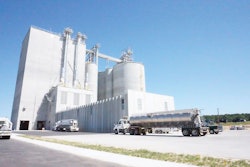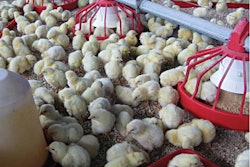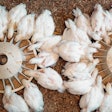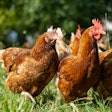
No single product will deliver the same performance as growth promoting antibiotics. But a combination of husbandry practices and products can help poultry growers avoid and mitigate health issues associated with antibiotic-free (ABF) production.
Dr. Charles Hofacre, president of the Southern Poultry Research Group, spoke about what the latest research on broiler antibiotic alternatives is teaching the industry during US Poultry’s 2017 Live Production, Welfare & Biosecurity Seminar in Nashville, Tennessee, on September 18, 2017.
Hofacre, also a professor emeritus at the University of Georgia, said the removal of antibiotics is bringing old diseases back into the equation and forcing producers to closely examine their husbandry practices. ABF, however, is in demand from consumers and retailers and the industry can earn a premium for ABF meat, so the industry must learn to cope with the challenges.
Do’s and Don’ts of antibiotic-free production
1. Don’t raise chickens 100 percent ABF: Chickens will get sick and they will need to be treated. Choosing to totally remove antibiotics from production and therefore denying sick animals the medicine they need creates an animal welfare issue. Although the producer may lose money by going this route, Hofacre said using necessary antibiotics is the right thing to do.
2. Do be careful with chick and egg quality: Chick quality and egg pack quality is extremely important in ABF programs. Chick quality covers a broad range of issues, including overheating issues in every step of the process: the hatchery, incubator, transport, brooding. All of those factors can affect success in an ABF program. If the chick quality is poor, more problems – like infected legs and hips – will follow.
3. Do expect more necrotic enteritis: Necrotic enteritis is part of ABF especially during the winter. It’s a given that a third to half of all chicken houses will experience some sort of infection. Poorer quality growers are more likely to deal with necrotic enteritis problems due to faulty feeding technique or equipment. Inconsistent feeding and feed disruptions will lead to more disease challenges.
4. Don’t clean out litter after each flock: Placing new litter in the house after every flock is one of the worst things to do for a no antibiotics ever (NAE) flock. Used litter is more absorbent than new litter.
5. Do combine a vaccine and chemical coccidiostat: Hofacre said no single vaccine works any better than the rest in his experience. However, the issue to focus on is the proper dosage for each bird. Combining a vaccine and a chemical coccidiostat helps ensure proper distribution of the treatment.
6. Do give at least 14 days of downtime in between flocks: If the downtime period is cut to 10 or even seven days, then the grower is asking for trouble. At least 14 days is necessary.
7. Do expect feed passage: Feed passage is going to happen. Expect it to increase after the second feeding. Passage of up to 15 percent is normal. Vegetarian diets can make the problem more severe.
8. Do monitor feeding closely: Feed changes at the wrong time can be a disaster. A change during the peak of the coccidiostat cycle can add further stress for the birds and lead to health problems. Higher protein diets can also lead to higher necrotic enteritis. Water quality also plays a role and farmers are encouraged to elevate their disinfection levels in ABF programs.
Effectiveness of antibiotic alternatives
Enzymes: Enzymes, like phytase, help birds digest nutrients so they don’t wind up feeding the wrong kinds of bacteria lower in the digestive tract. Research shows phytase can drop necrotic enteritis infection rates by half.
Prebiotics: Ideally, prebiotics are a food source for the desired gut flora rather than the undesirable. For instance, Hofacre said, organisms that produce butyric acid are positive for the gut environment. Again, the products don’t work as well as growth-promoting antibiotics, but mannan-oligosaccharides (MOS) products can help improve feed efficiency and reduce mortality.
Probiotics: Probiotics are the “good bugs,” Hofacre said. They stabilize and balance the intestinal microbiota and limit the population of pathogenic bacteria. Bacillus products in particular can be placed in the feed and survive elevated temperatures to facilitate the consistency of product delivery among many flocks fed by different growers. Probiotics can help elevate weight gain and improve feed efficiency. The effectiveness of probiotic products can vary greatly and it may be, he said, that a rotation of different products is needed for the greatest effect.
Organic acids: These products work well as antibiotic compounds because they get taken up into the bacteria and cause cell death through a biological process. In a way, Hofacre said, they are antimicrobials and an important piece of the ABF puzzle. Complex organic acids target the lower gut to control clostridium and other bacteria. Organic acids used as a treatment or a continuous feed additive can improve feed conversion and body weight.
Phytoceuticals: A variety of products with an origin as a plant product or plant extract — also referred to as phytogenics — are appearing on the market and show usefulness as an alternative to antibiotics. The products work either as antimicrobials, supplements to improve immune response or help birds improve their ability to metabolize toxins. While some may be skeptical of their utility, a recent essential oils study with a necrotic enteritis challenge showed how the product helped improve body weight gain and feed efficiency while lowering mortality. As they are more understood, they will play a big role in controlling coccidia in ABF programs, Hofacre said.

















